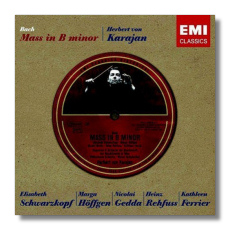
The Internet's Premier Classical Music Source
Related Links
- J.S. Bach Reviews
- Latest Reviews
- More Reviews
-
By Composer
-
Collections
DVD & Blu-ray
Books
Concert Reviews
Articles/Interviews
Software
Audio
Search Amazon
Recommended Links
Site News
 CD Review
CD Review
Johann Sebastian Bach

Mass in B minor
Elisabeth Schwarzkopf, soprano
Marga Höffgen, Kathleen Ferrier, contraltos
Nicolai Gedda, tenor
Heinz Rehfuss, bass
Singverein & Orchester der Gesellschaft der Musikfreunde in Wien
Philharmonia Orchestra; Vienna Symphony Orchestra/Herbert von Karajan
EMI Classics 5 86838 2 ADD mono 2CDs: 72:01, 75:33
Karajan's first recording of the Bach B-minor Mass, recorded in London (solos) and Vienna (choruses) between 1952 and 1953 has been released on CD at least three times. This most recent release is the most inexpensive yet, so if you've been holding out, here's your chance.
You might assume that a recording made over several months and in two cities might lack flow from one section to the next, but that is not the case. Furthermore, it is good to remember that Bach himself assembled this mass from material written earlier in his career, so a patchwork recording of this work is not without historical precedent!
The alternation between choruses and arias (many of them accompanied by an instrumental soloist) mirrors the contrast between the communal and the private in an actual mass. How can music (or an actual Roman Catholic or Lutheran mass, for example) be all-encompassing and intimate at the same time? That is the question Karajan seems to be answering in this recording, and he answers it quite effectively by contrasting the choruses and the arias as much as he can. (No doubt the different recording locales and dates assisted him.)
It is common to complain about Karajan's "romantic" readings of Classical and Baroque works, and listeners seeking a recording in which the mass is performed much as it was during Bach's time will have to look else where: this is not an "period" performance by any stretch of the imagination. Karajan's emphases, apart from making music of celestial beauty, are on the opposite poles of intimacy and grandeur. Furthermore, one would be hard-pressed to find a recording with a more devout atmosphere than this one. When Karajan died, perhaps he appeared in front of St. Peter holding CDs of this recording as proof of his fitness to enter!
The choral singing, while it has weight, is very clear and articulated, although it sounds almost affected in the "Cum Sancto Spiritu" and in parts of the "Osanna in excelsis." The engineering, which gives the chorus a very dark sound, mitigates the potentially negative impact of this extreme articulation.
Gedda and Rehfuss have momentary problems with pitch, but they give very human and comforting readings – not at all operatic – of their respective solos. Höffgen is deeply moving and personal in the "Qui sedes," and Schwarzkopf is in rapt form throughout, without the coolness that sometimes stands between her and the listener in some of her later recordings.
As a bonus, this CD includes the five solos and duets for soprano and/or contralto as sung by Schwarzkopf and Ferrier on June 15, 1950. These "experimental" recordings come from rehearsal sessions prior to an actual concert in Vienna, and were not intended for commercial release. As a result, the orchestral introductions and "outroductions" are cut a little short. Nevertheless, these 22 minutes of excerpts are treasurable, and both of them catch Schwarzkopf and Ferrier at their absolute peak, singing with a beauty that they rarely attained under studio conditions. Only two microphones were used, but the sound-picture is full and complete. Expect extraneous noises too – this is a rehearsal, after all.
Surprisingly, the booklet contains not just essays about these recordings, but Latin texts and translations as well.
Copyright © 2005, Raymond Tuttle




















